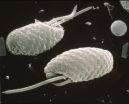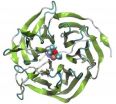Quantum biology: Algae evolved to switch quantum coherence on and off
2014-06-16
(Press-News.org) A UNSW Australia-led team of researchers has discovered how algae that survive in very low levels of light are able to switch on and off a weird quantum phenomenon that occurs during photosynthesis.
The function in the algae of this quantum effect, known as coherence, remains a mystery, but it is thought it could help them harvest energy from the sun much more efficiently.
Working out its role in a living organism could lead to technological advances, such as better organic solar cells and quantum-based electronic devices.
The research is published in the journal Proceedings of the National Academy of Sciences.
It is part of an emerging field called quantum biology, in which evidence is growing that quantum phenomena are operating in nature, not just the laboratory, and may even account for how birds can navigate using the earth's magnetic field.
"We studied tiny single-celled algae called cryptophytes that thrive in the bottom of pools of water, or under thick ice, where very little light reaches them," says senior author, Professor Paul Curmi, of the UNSW School of Physics.
"Most cryptophytes have a light-harvesting system where quantum coherence is present. But we have found a class of cryptophytes where it is switched off because of a genetic mutation that alters the shape of a light-harvesting protein.
"This is a very exciting find. It means we will be able to uncover the role of quantum coherence in photosynthesis by comparing organisms with the two different types of proteins."
In the weird world of quantum physics, a system that is coherent – with all quantum waves in step with each other – can exist in many different states simultaneously, an effect known as superposition. This phenomenon is usually only observed under tightly controlled laboratory conditions.
So the team, which includes Professor Gregory Scholes from the University of Toronto in Canada, was surprised to discover in 2010 that the transfer of energy between molecules in the light harvesting systems from two different cryptophyte species was coherent.
The same effect has been found in green sulphur bacteria that also survive in very low light levels.
"The assumption is that this could increase the efficiency of photosynthesis, allowing the algae and bacteria to exist on almost no light," says Professor Curmi.
"Once a light-harvesting protein has captured sunlight, it needs to get that trapped energy to the reaction centre in the cell as quickly as possible, where the energy is converted into chemical energy for the organism.
"It was assumed the energy gets to the reaction centre in a random fashion, like a drunk staggering home. But quantum coherence would allow the energy to test every possible pathway simultaneously before travelling via the quickest route."
In the new study, the team used x-ray crystallography to work out the crystal structure of the light-harvesting complexes from three different species of cryptophytes.
They found that in two species a genetic mutation has led to the insertion of an extra amino acid that changes the structure of the protein complex, disrupting coherence.
"This shows cryptophytes have evolved an elegant but powerful genetic switch to control coherence and change the mechanisms used for light harvesting," says Professor Curmi.
The next step will be to compare the biology of different cryptophytes, such as whether they inhabit different environmental niches, to work out whether the quantum coherence effect is assisting their survival.
INFORMATION:
The team was led by UNSW's Dr Stephen Harrop and Dr Krystyna Wilk and includes researchers from the University of Toronto, the University of Padua, the University of British Columbia, the University of Cologne and Macquarie University.
Media contacts:
Professor Paul Curmi: + 612 9385 4552, p.curmi@unsw.edu.au
UNSW Science media officer: Deborah Smith, + 612 9385 7307, +61 (0) 478 492 060, deborah.smith@unsw.edu.au
ELSE PRESS RELEASES FROM THIS DATE:
Quantum theory reveals puzzling pattern in how people respond to some surveys
2014-06-16
COLUMBUS, Ohio – Researchers used quantum theory – usually invoked to describe the actions of subatomic particles – to identify an unexpected and strange pattern in how people respond to survey questions.
By conventional standards, the results are surprising: The scientists found the exact same pattern in 70 nationally representative surveys from Gallup and the Pew Research center taken from 2001 to 2011, as well as in two laboratory experiments. Most of the national surveys included more than 1,000 respondents in the United States.
"Human behavior is very sensitive ...
Computation leads to better understanding of influenza virus replication
2014-06-16
Treating influenza relies on drugs such as Amantadine that are becoming less and less effective due to viral evolution. But University of Chicago scientists have published computational results that may give drug designers the insight they need to develop the next generation of effective influenza treatment.
"It's very hard to design a drug if you don't understand how the disease functions," said Gregory Voth, the Haig P. Papazian Distinguished Service Professor in Chemistry. Voth and three co-authors offer new insights into the disease's functioning in the Proceedings ...
Chemical strategy hints at better drugs for osteoporosis, diabetes
2014-06-16
MADISON, Wis. — By swapping replacement parts into the backbone of a synthetic hormone, UW–Madison graduate student Ross Cheloha and his mentor, Sam Gellman, along with collaborators at Harvard Medical School, have built a version of a parathyroid hormone that resists degradation in laboratory mice. As a result, the altered hormone can stay around longer — and at much higher concentration, says Gellman, professor of chemistry at the UW.
Hormones are signaling molecules that are distributed throughout the body, usually in the blood. Hormones elicit responses from only ...
No correlation between baby formulas and development of diabetes-associated autoantibodies
2014-06-16
ATLANTA—There is no correlation between the consumption of a cow's milk-based formula or hydrolyzed protein formula and the development of diabetes-associated autoantibodies in children younger than seven, according to a worldwide research study published in the Journal of the American Medical Association (JAMA).
The Trial to Reduce Insulin Dependent Diabetes Mellitus in the Genetically at Risk (TRIGR) study, which examines possible reduction in autoantibodies associated with type 1 diabetes, tracked children genetically predisposed to type 1 diabetes for seven years.
It ...
Controlling ragweed pollen in Detroit: A no-mow solution for Motown?
2014-06-16
ANN ARBOR—When it comes to controlling hay fever-triggering ragweed plants on Detroit vacant lots, occasional mowing is worse than no mowing at all, and promoting reforestation might be the best solution.
Those are the findings of a new University of Michigan study that surveyed vacant lots in several Detroit neighborhoods for ragweed, counting the number of ragweed plants and estimating how often each lot was mowed.
The researchers found that ragweed was significantly more likely to be present in vacant lots mowed once a year or once every two years—a common practice ...
In managing boundaries between work and home, technology can be both 'friend' and 'foe'
2014-06-16
When it comes to managing boundaries between work responsibilities and home life, technology is our "frenemy."
Technology, specifically mobile technology, can be alternately used to maintain, erase or manage home and work boundaries along a spectrum.
That's according to ongoing research by the University of Cincinnati to be presented June 17 at the Work and Family Researchers Network Conference in New York City by Stacie Furst-Holloway, UC associate professor of psychology. Co-authors with Furst-Holloway on the research are Elaine Hollensbee, associate professor of ...
University of Tennessee discoveries could help neutralize chemical weapons
2014-06-16
KNOXVILLE—Researchers at the University of Tennessee, Knoxville, are a step closer to creating a prophylactic drug that would neutralize the deadly effects of the chemical weapons used in Syria and elsewhere.
Jeremy Smith, UT-ORNL Governor's Chair and an expert in computational biology, is part of the team that is trying to engineer enzymes—called bioscavengers—so they work more efficiently against chemical weapons. The work is a joint effort between scientists at UT, Oak Ridge National Laboratory and a French national laboratory in Grenoble. Their study was published ...
Migratory birds help spread plant species across hemispheres
2014-06-16
A new study out of the University of Connecticut demonstrates for the first time how some plants travel not just across the backyard, but as far as from Northern to Southern hemispheres on the wings of migratory birds.
The findings, published in the online journal PeerJ, offer critical insight into the ecology and evolution of plants that are represented across both continents of the Americas.
The study found 23 regenerative plant diaspores – plant seeds or spores – trapped in the feathers of migratory birds leaving the Arctic harbor for South America.
Although wind ...
Vitamin A derivative potentially treats type 2 diabetes and prevents its complications
2014-06-16
At a time when obesity, type 2 diabetes, and their complications are a veritable epidemic worldwide, researchers at the University of Montreal and CHUM Research Centre (CRCHUM) recently demonstrated the potential of retinoic acid (RA), a derivative of Vitamin A, in treating obesity and type 2 diabetes and preventing their cardiovascular complications. The findings were presented June 6, 2014 at the Annual Conference of the Canadian Nutrition Society in Saint John's, Newfoundland.
"In obese and insulin resistant mice, retinoic acid reduces the risk of cardiac apoptosis, ...
Researchers use virus to reveal nanopore physics
2014-06-16
PROVIDENCE, R.I. [Brown University] — Nanopores may one day lead a revolution in DNA sequencing. By sliding DNA molecules one at a time through tiny holes in a thin membrane, it may be possible to decode long stretches of DNA at lightning speeds. Scientists, however, haven't quite figured out the physics of how polymer strands like DNA interact with nanopores. Now, with the help of a particular type of virus, researchers from Brown University have shed new light on this nanoscale physics.
"What got us interested in this was that everybody in the field studied DNA and ...


